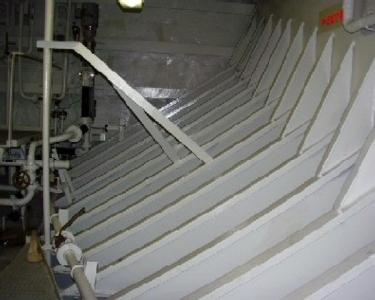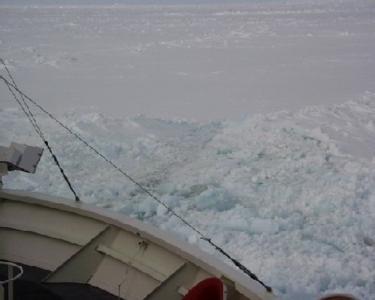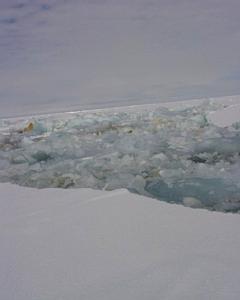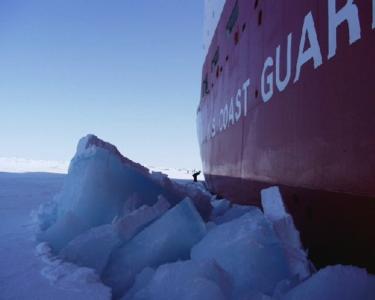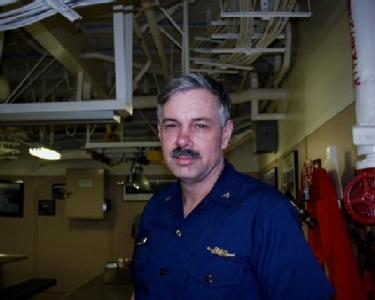
|
16 May, 2000Backing and Ramming DRAFT May 16, 2000 Daily Data (20:30): Lat. 6121.516N Long. 05846.181W Heading 159.685 deg Air Temp. 2.33C 36.30F True Wind Dir. 090 deg True Wind Speed 10 knots USCGC Healy Facts: Science Systems Staging Areas for Science Operations-Starboard staging area provided with a bridge crane & hoist, roller door access to weather deck, direct access to wet lab, science conning station and holds. Aft staging area for fantail work and snowmobile on deck stowage. Dear Everyone, The Healy is steaming south in open water. It's cloudy and drizzling lightly. With temperatures now above freezing, the heat and humidity are noticeable. I miss the brilliant sparkling snow and ice, the beauty of the evening sunlight streaming across expansive snow covered floes, the seemingly endless days of Arctic light (refer to my journal entry of May 8, 2000 “Sunrise and Sunset”), the wildlife of the far north. And, yes, the traversing through the ice and the backing and ramming maneuvers of the Healy. When I made my treasured evening climb to the tranquility of the bridge for my daily data and as I tell everyone, to refresh my soul with beauty, Mike Healy (Engineering Logistics Center, Baltimore, Maryland), on his daily trafficability studies watch observed, "You're melancholy, aren't you? You don't want to leave." "Yes," I nodded as I continued gazing at the low light illuminating the floes of first-year ice. Everyone knows I love the ice, the Arctic, the ship. What is backing and ramming? The theory, the strategies? To answer these questions, I went to Captain Garrett, the USCGC Healy's Commanding Officer (CO), and to retired Coast Guard Captain of icebreaking experience, Bob Parsons, Parsons Associates International, Bellevue, Washington. The ability of an icebreaker to break ice is dependent upon the amount of power generated by the ship's propulsion and the weight of the displacement of the ship to press against the ice. Captain Garrett compares this to successfully driving a nail. It is dependent upon the strength of the arm and the strength of the hammer. The Healy was designed to break 4.5 feet of 100-psi (pounds per square inch) ice at a continuous speed of 3 knots. At the point when ships cannot successfully break ice continuously, the strategy of backing and ramming is implemented. Backing and ramming is used to break ice that is too thick or under too much pressure (i.e. ridges and rubble fields) for the ship to pass through continuously. Icebreakers have a bow that is designed to ride up onto the ice and then press it down to crack and break it. The same occurs with level ice or ridges. This is an issue of force, of the flexural strength of the ice and the weight and pressure of the ship. Backing and ramming, breaking ice, is more of an art than a science. Bob Parsons tells me that the last book written on the practices and procedures of icebreaking was written over 25 years ago. Less than six pages, Bob says, are designated to the topic in books about ship handling. There are some basic premises, or goals, to the theory of icebreaking. Travel in open water, even if circuitous, is the preference. The basic thought is not to break more ice than must be broken, to around it versus through it. Mobility is the goal. It's about getting from point A to point B in the most efficient manner even though the course may be indirect. It is not necessarily to break ice. Icebreaking and backing and ramming require time and can be laborious and pose a threat to the ship (i.e. vibrations, damage to propellers). The art of backing and ramming is the skill in observing the ice itself. Ice is very different in its thicknesses and qualities. The art is the ability to make the best decisions for the easiest and most efficient backing and ramming options based upon the conditions of the ice. A good conning officer will know how the ship and the ice will react under given conditions and use this knowledge for the best mobility advantage. Patience is also a part of this art. With a given power and vessel capabilities, the ice requires its own time and cannot be hurried. Backing and ramming necessitates time. Having the skills and the knowledge of the capabilities of the ship and how it responds is a contributing factor to the art of backing and ramming. This knowledge may include, for example, the response time for the propellers to change directions, the responsiveness of the engines and the ship's maneuverability. Having this information facilitates the speed of the icebreaking process. One backing and ramming technique that is parcticularly successful employs two or three rams that are targeted alternately from center first and then ramming from one side to the next before moving ahead. This strategy provides a wider track or channel for the ship when it backs before ramming again. This may be necessary in difficult ice conditions in order to prevent the brash ice (the ice the ship breaks left in its wake) from gripping the ship's sides as it pushes forward when ramming. The staggered ramming method aids maneuverability and assists in the prevention of becoming beset (stuck or pinched). The strongest part of the ship is the bow. The strength not only results from the ship's plating but the framing of the bow. The weakest part of the ship is the stern due to the propellers. In order to prevent damage from encountering blocks of ice when backing, the rudders must be kept amidship (mid-center) or parallel with the centerline. If they are turned and not parallel with the centerline, then they could potentially break if they strike ice. The Bow Wash System (deluge system) is employed when there is an abundance of snow. Heavy snow renders the ship less capable and consequently slows it down. Water spouts from each side of the bow to wash the snow off the ice and to provide a liquid lubricant to the sides of the ship. This system reduces the friction of the snow against the ship and lessons the resistance. It facilitates the ship's forward movement over the ice. (Refer to my journal entries of May 6, 2000 "Profiling Ice Thickness," paragraph 12 and May 10, 2000 "Testing Snow Density," paragraph 4.) In addition to the Bow Wash System, the Healy has a specialized slick black non-porous coating on the bottom of the ship that has the effect of Teflon. It assists the Healy in sliding through snow and ice by reducing friction (interaction of the hull and ice). What makes the Healy so successful in it's backing and ramming functions? The Healy has responsive engines, good maneuverability, easy to operate controls, excellent visibility from the aloft conning station, and is efficiently and smartly designed. These factors significantly reduce the Healy's prospects of becoming beset. What are the basics of backing and ramming? According to Bob Parsons, point the ship where you want it to go, give it all the power you've got, when the ship gets stuck (stops) then back and repeat this process. Data on ice core 5A of April 11, 2000 follows. Best regards, Sandra Kolb For further information: ../ http://www.uscg.mil./pacarea/healy Core 5A level ice 0411, End of Start-Up Test 11-April-00 Total length 66 cm Latitude 63 deg 16.76 min Longitude 62 deg 09.53 min Comments: air temp -10.7 C, winds 16 knots @ 221.9 true, end of test Brine volume for -2>T>-22.9 Brine volume coefficients:
average brine vol 0.0704 average strength mpa 0.370 average strength psi 53.6
Contact the TEA in the field at . If you cannot connect through your browser, copy the TEA's e-mail address in the "To:" line of your favorite e-mail package. |







